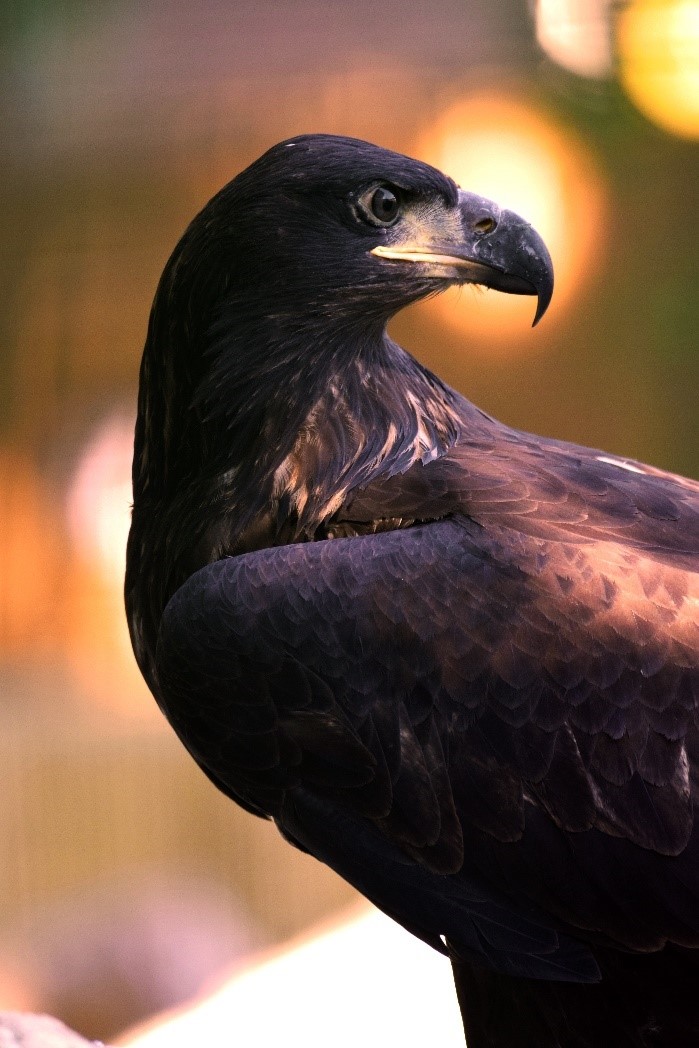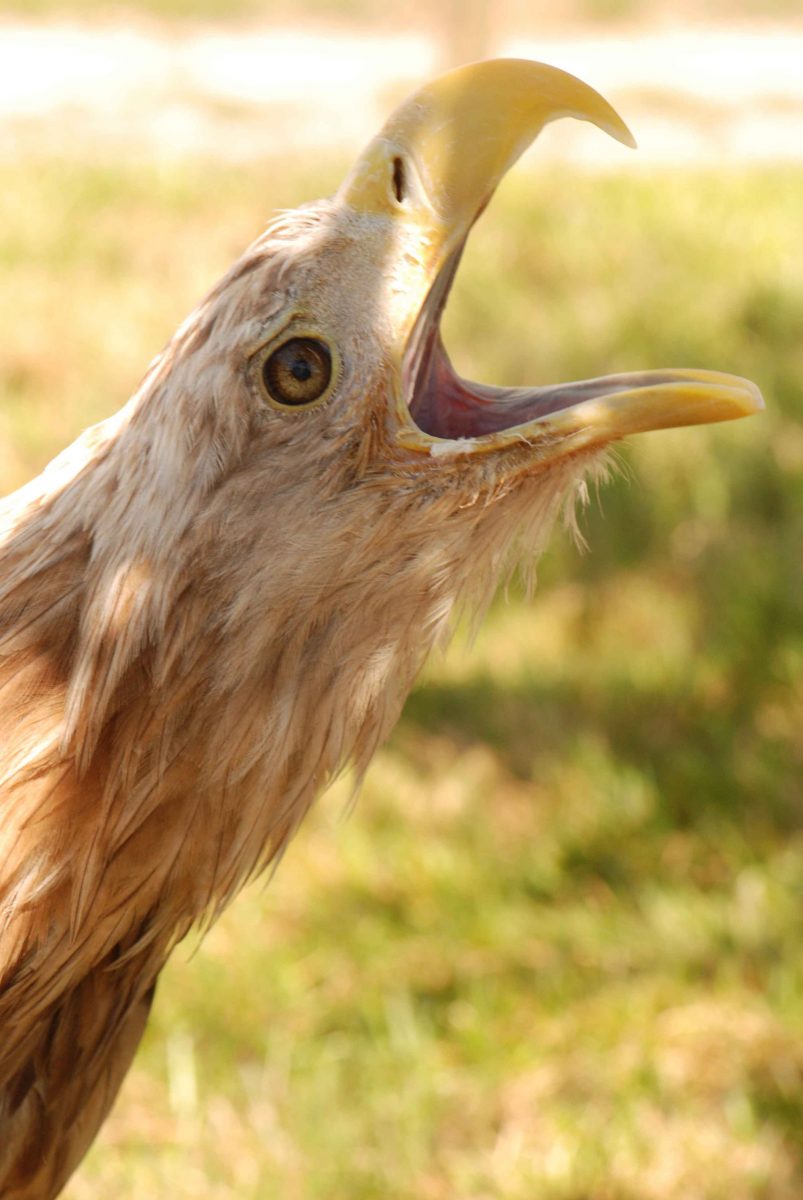An unusual bird
Presentation
The white-tailed sea eagle is one of the largest diurnal raptors in Europe. The total length of the adult bird is 70-100 cm, with a wingspan of 190-250 cm. Its weight varies from about 4 kg for the male to 6 kg for the female. The plumage of the adults is brown except the head and neck which are lighter. The wings are long and rectangular, their tips reach the tip of the tail. The head is large, the neck is powerful, and the strong beak is entirely yellow. The short and fan-shaped tail-shaped tail is entirely white. The legs are yellow. Apart from this difference in size and weight, sexual dimorphism is not very marked (Ferguson-Lees, Christie, Franklin, Mead, & Burton, 2001). A complete molt takes place over several years, mainly between April and October.
Fish-catching eagles have two-thirds bare tarsi, plantar soles covered with rigid spicules, rather short toes, and highly arched talons that allow them to capture and hold large fish (Orabi P, 2012). Juveniles are darker, especially at the head, and have a variably light spotted mantle. The tail is largely dark, the bill is black, and the iris is quite dark. In subadults, the tail has a dark terminal band, before turning white. Five to six plumages can be distinguished in this species. Age determination is possible up to and including the 4th plumage, knowing that there are individual variations in plumage between two birds of the same age which can lead to an erroneous age estimation ( LOANA (Lorraine Association Nature) published in 2016 a guide to help identify the different plumages of the White-tailed sea eagle as part of the Regional Action Plan 2015-2020 on sea eagles in Lorraine ).


Physiology
The National Action Plan for the eagle states:
It is from the age of 5 or 6 years that the eagle begins to reproduce but observations of subadult reproduction have already been made for pairs formed before the average age of sexual maturity of individuals. White-tailed sea eagles prefer to nest on tall trees (deciduous trees usually over 10 m high or conifers), usually in the upper third of the tree, but may also build their nests on steep rock faces, more rarely on the ground. The nest is made of large dead branches, lined with mosses, lichens, dry grass, … Nesting areas are rare on infrastructure such as electricity pylons or towers.
Eagles refill their nests each year in late winter, with the male providing most of the materials while the female arranges the nest. Fresh plant material continues throughout the breeding season. The eagle may have several sites on its breeding territory. Egg laying takes place from late January to late April, depending on latitude and climate. The female lays 1 to 3 eggs, usually 2, incubated in turn by the two adults for about 35 to 38 days. At hatching, the chicks weigh 80-95 g to reach 4-6 kg before fledging. The fledging of the young occurs between 2 months and half and 3 months after the hatching. After fledging, they are still fed by the adults for 4 to 5 weeks, then they gradually disperse on the parental territory during the third month. The young reach sexual maturity at about 5 years of age. In healthy populations, reproductive success reaches 60-80% and the number of young fledged is 1.5 (in Germany, between 1991 and 2005) (Sulawa, Robert, Köppen, Hauff & Krone, 2010).
Juvenile White-tailed Eagle. Photo credit Les Aigles du Léman.
The nest. Photo crédit Rémi Chapeaublanc.
Diet of the white-tailed sea eagle:
The white-tailed sea eagle has a rather varied diet, depending on local resources and the season: it feeds mainly on dead or live fish that it catches, as well as captures water birds (ducks, coots, grebes, gulls, etc.) and mammals. It is an opportunist that sometimes feeds on carrion, especially in winter. It does not hesitate to take food from other birds (Osprey, gulls, and cormorants) or from mammals (otters). Eagles forage primarily near the nesting area (4-7 km), but the pair’s range can reach 15-30 km (Patier et al, 2015). Like the Osprey, it takes fish in shallow water after spotting them in flight or from a perch.
According to a study conducted in Germany on 5 pairs of eagles, they prefer to catch bream and pike and avoid perch, roach, and eel. In general, the size of the prey seems to be decisive: eagles prefer fish of 30-50 cm, those larger than 50 cm are not consumed (Nadjafzadeh et al, 2015). Work has shown that adult white-tailed sea eagles require 500 g of fish or 300 g of bird or mammal flesh daily; the daily requirements of juveniles are about 800 g, mostly of fish (Orabi, 2012).

History in France:
From popular expression to hated animal…
The French ornithological literature finally makes little room for the white-tailed sea eagle. There are no engravings attesting to the presence of eagles but a popular expression: “Pousser des cris d’Orfraie” This expression comes from the extremely high-pitched cries that these birds utter at the time of the reproduction period. Eagle was the name of the white-tailed sea eagle in the Middle Ages. Few animals have given popular expressions : the wolf, the bear and thus the white-tailed sea eagle. This indicates that it was necessarily very present in the country. This is confirmed by authors who claim that eagles were nesting everywhere in France in the 18th century. Then the persecutions made its population decline in a dramatic way. Flourens mentions a nesting in the forest of Chambord in 1780 then Victor Fatio describes very precisely the last nesting in continental France in the forest of Ripaille in Thonon les Bains (Haute-Savoie) in 1892 In Corsica, the bird nested until the late 1950s, early 1960s.
2011: The natural return
In 2011 a couple comes to settle naturally in Lorraine and raises successively nestlings. It will be necessary to wait until 2018 to see two other couples settle in Brenne and in Champagne. A 4th pair seems to settle in 2020 between the Marne and the Meuse but without finding the nesting area. The return of the eagles in France shows the extreme fragility of this population and the project of a reintroduction program aiming at reinforcing the latter but also at conquering new territories is quickly imposed as a necessary action for the perennial return of the species in France.
2022-2030: The reintroduction program
From 2022 onwards, the reintroduction program for the white tail sea eagle will take place on the site Les Aigles du Léman, in the commune of Sciez, on the shores of Lake Geneva. 6 birds will first be reintroduced to test all the elements of the program (breeding, method, installation of GPS, surveillance system by cameras…) If all goes well, 80 birds will be released on the Lake Geneva basin. The objective is to recreate a population of 3-4 pairs on the shire of the lake and to start the colonization of the upper Rhône, a region targeted as a priority by the National Action Plan.